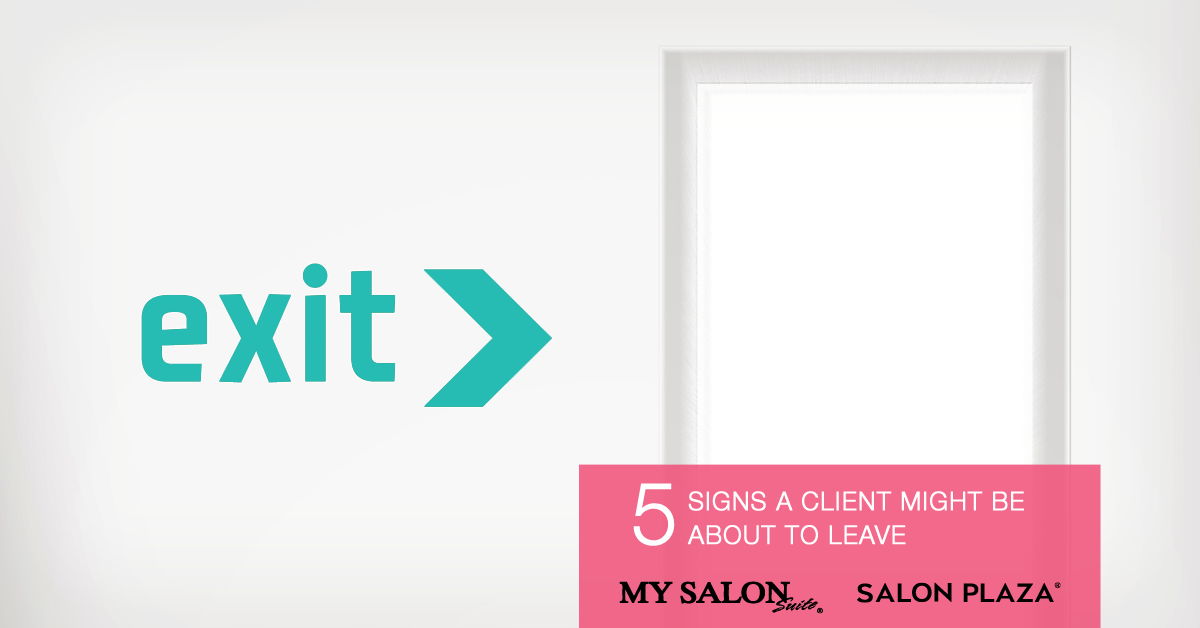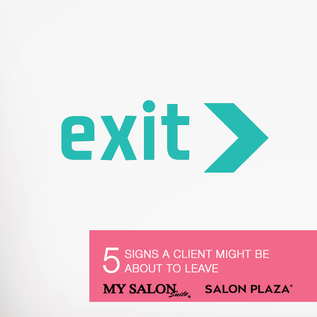
Suite Success Secret #61
5 Signs You Might Be About to Lose a Client
91% of unhappy clients will leave without ever telling you why. As a business owner, knowing how to spot signs of client dissatisfaction can help you identify early warning signs that one of your Salon Suite’s clients may be about to leave, and give you a chance to address it before they are gone for good.
ACTION STEPS
Learn how to listen for indirect clues your clients provide and address any perceived dissatisfaction as quickly as possible.
We’ve talked a lot about client love and loyalty over the past few weeks, but there is a flip-side to that coin: Client defection.
Successful business owners aren’t just concerned with bringing in new clients, they’re committed to keeping them, too. Client retention is vital if you want to grow to the next level, otherwise you’ve just got a revolving door, and you have to work twice as hard to bring in new clients just to replace the ones who aren’t coming back. Statistically, Salon Suite clients will leave for one of these five reasons:
- 3% – Move away
- 5% – Develop other affiliations
- 9% – Are attracted away by competitors
- 14% – Are dissatisfied
- 68% – Don’t think you care (indifference)
You can’t do anything about clients moving, and if they develop other affiliations (such as when they have a close friend or family member who becomes a beauty professional, or take a job in the opposite direction of your Salon Suite that makes it impractical for them to stay) it might not be something that you can overcome, either.
However, that may only account for about 92 percent of client defections. It’s this body of Salon Suite clients who may be on the verge of leaving where you have the most opportunities to prevent defections and improve client retention. Nine of out ten unhappy clients won’t come out and tell you why they are leaving, but they may drop hints along the way. Here are a few signals clients may send.
1. Blow Something Out of Proportion
If one of your clients over-reacts to a slight inconvenience (such as if you need to rebook them in the case of emergency schedule changes, their favorite product is out of stock, an appointment ran late and they had to wait 10-15 minutes, etc.) or a minimal price change, or some other aspect of the customer experience that should not have been a big deal, it could signal deeper dissatisfaction and might be the last thing that occurs before they leave. Your client might be looking for a reason to justify leaving, and blowing up a small nothing into a big something could be a tactic they use to avoid telling you why.
2. Social Media Activity
Social media provides you with the opportunity to engage with your clients in between appointments and better-understand their unique needs and lifestyle. It can also give you indications that something is wrong in the client relationship; such as when a client who used to engage with you on social media stops liking or commenting on your posts, or one of your clients starts asking their networks for salon recommendations.
3. Hints
Just because a client doesn’t lodge a formal complaint or leave a bad review doesn’t mean they are completely satisfied. They may drop hints before they decide to leave about aspects of the client experience at your Salon Suite they aren’t happy with; for instance:
- Saying something is – or is getting – “too expensive”
- Feeling stressed about having to leave work early to get to their appointments
- Feeling frazzled about having to drive “so far” or so far out of their way to come to your Salon Suite
- Expressing mild disappointment with their hair cut, color, or some other result, or even suggesting it just wasn’t what they expected
Remember that many people avoid conflict. Small hints at dissatisfaction could be masking real unhappiness. Instead of dismissing these minor complaints, ask questions and make it safe for clients to tell you if they are truly unhappy with some aspect of their experience.
4. No Shows
Sometimes no-shows are a good thing; they give you an opportunity to dis-engage with a client who might be more inconvenience than the value they provide. In other cases, no shows can be an indication that clients don’t think you care, so they don’t think that calling ahead to rebook or giving you notice they can’t make an appointment even matters.
It’s ok to remind your clients that a no-show impacts your business and develop a written policy. After all, you can’t suddenly conjure up a replacement client if another doesn’t show up. Decide what type of cancellation window (24 hours, 48 hours, etc.) you need in order to fill a hole in your schedule at the last minute. Write scripts that you can use to text or email no-shows. Reward clients for “perfect attendance.” Decide how many chances a client will receive before you ask them to move on, so that you can fill their spot with a client who truly values your services.
5. Declines to Rebook
Especially for clients who normally rebook in advance, if they decline to do so it could be a sign they are considering other options. If one of your clients declines to rebook and you’re not sure why, let them know that you value their business and want to make sure that nothing is wrong. Conversations like these can be difficult; however, wouldn’t you rather know if a client is unhappy or considering making a change for some other reason? You might not have the chance to keep them from leaving, but at least you’ll know why!





